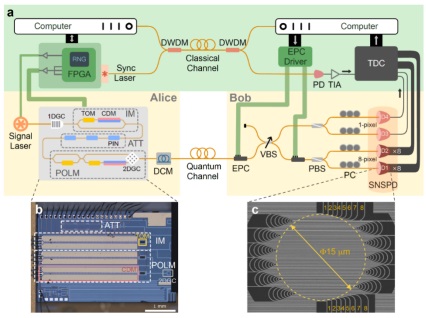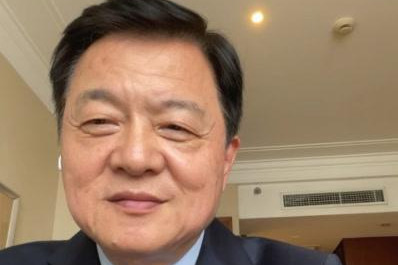Team develops method for better quantum communication


A Chinese research team has developed a new method for quantum communication, achieving secure communications at a distance of more than 615 kilometers.
The transmission, using a newly designed open configuration of twin-field quantum key distribution, only requires half the amount of optical fiber normally required by conventional closed channels. The innovation shows promise for the building of a wide area quantum network in the country, according to study findings recently published in the journal Nature Communications.
Quantum key distribution allows for the exchange of cryptographic keys securely between shared parties.
Of all the QKD protocols, twin-field is the most viable solution for long-distance secure fiber communication. The communication users of both parties transmit their own optical fields independently to meet at an intermediate station for interference in a twin-field QKD configuration.
The interference outcome is used by the two users for their information reconciliation, so it is important to keep the mutual phase stable. However, the phase varies violently in practice, caused by the frequency difference between the lasers from both parties and the rapid phase fluctuation of the long fiber.
To remedy this problem, the previous configurations of twin-field QKD had adopted a gigantic and resource-inefficient interferometer structure, which means that besides the essential quantum fiber between the QKD's two parties, an additional fiber called the service fiber is needed for optical frequency dissemination, said Yuan Zhiliang, chief scientist at the Beijing Academy of Quantum Information Sciences.
The research team led by Yuan introduced a new technique that stabilizes an open channel without using a closed interferometer or the service fiber, and successfully achieved quantum communications at a distance of 615.6 km.
Zhou Lai, a team member from the BAQIS, explained their findings, noting that in the traditional methods, two lines are necessary for quantum communication between two sites about 615 km apart, while with the new method, one line is enough.
In the twin-field QKD with their open configuration, the team adopted optical frequency comb technology to replace the conventional service fiber to calibrate the frequency of lasers from both parties in the quantum communication, realizing accurate information transmission.
Zhou illustrated the frequency comb as turning a beam of light with a single frequency into multiple beams of light with different frequencies, which are "separated like the row of teeth on a comb".
The frequency comb technology serves the additional function of solving the problem of fiber drifts, which inevitably occur during long-distance quantum communication, Zhou said, explaining that the comb works by greatly reducing the impact of noise on quantum signals, thus ensuring the accuracy of information transmission over long distances.
During an interview with Xinhua, the team demonstrated their research results through an optical fiber with a core diameter of about 10 microns and a length of 615 km, successfully completing the long-distance quantum communication.
The twin-field QKD system with the open configuration is still relatively large, and the team is currently in the process of developing a photonic chip measuring 1 square centimeter to integrate various device modules used in the QKD system, Yuan said.
"Once the chip has been successfully developed, devices used for quantum communication could be carried around like portable laptops," he added.
Xinhua
- Ancient fish fossil find places puzzling species among jawed vertebrates
- China vows to achieve reunification, counter separatism
- China-donated tents seen in relief shelter in Mandalay, Myanmar
- New star orators born as over 1,500 HK students vie for honors
- Seminar urges growth of people's well-being on both sides of Taiwan Strait
- Xi reaffirms China's commitment to friendly cooperation, international equity





































